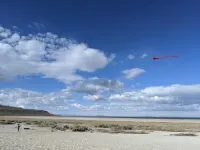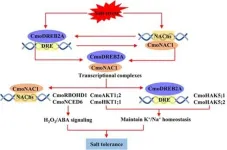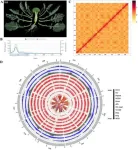The papers are publishing in advance of a Cell Press 50th Anniversary sustainabiltiy forum on the topic of “Navigating the Pyrocene: Managing fire risk in a warming world.” The virtual event, free to register, takes place Thursday, July 11, 2024 at 11:00 am ET.
This collection of Cell Press journal content related to fire includes the following:
Wildfires increasingly threaten oil and gas wells in the western United States with disproportionate impacts on marginalized populations (research article in One Earth) https://www.cell.com/one-earth/fulltext/S2590-3322(24)00256-2 University of California, Berkeley environmental health scientist David J.X. González (@davidJXgonzalez) and colleagues found widespread historical and projected future overlap between wildfires and oil and gas development in the western United States. Combined with recent increases in wildfire activity, this increases potential health risks for local populations, particularly in communities of color, and introduces new hazards.
Reimagining a pathway to reduce built-environment loss during wildfires (commentary in Cell Reports Sustainability) https://www.cell.com/cell-reports-sustainability/fulltext/S2949-7906(24)00194-0 Civil and environmental engineer Hussam Mahmoud (@HussamN_Mahmoud) of Colorado State University argues that more can be done to mitigate against wildfire risks caused by communities expanding into forest-dense areas, which lead to changes in natural vegetation and increased human activity. Preparedness programs and related outreach initiatives can support neighborhood growth while enhancing residents’ ability to respond to these events.
Technological solutions for living with fire in the age of megafires (commentary in One Earth) https://www.cell.com/one-earth/fulltext/S2590-3322(24)00260-4 Environmental engineers and scientists Marta Yebra (@Myebra12), Robert Mahony, and Robert Debus (@BobDebus1) of the Australian National University describe some of the high-tech options for early fire detection and rapid ignition suppression, ranging from sensors, cameras, aerial vehicles, and satellites, that can increase safety for firefighters or ground crews, but work is needed to assess the benefits and costs related to implementation.
Model fires not ignitions: Capturing the human dimension of global fire regimes (commentary in Cell Reports Sustainability)
https://www.cell.com/cell-reports-sustainability/fulltext/S2949-7906(24)00203-9 A team led by Matthew Kasoar and Oliver Perkins of the Leverhulme Centre for Wildfires, Environment and Society argue that global fire models overwhelmingly frame people’s ignition of fires as random events versus being actively planned and put out. Their data supports the idea that more useful models, while challenging to develop, would represent fires that spread naturally as well as those being managed by humans.
Intense formation of secondary ultrafine particles from Amazonian vegetation fires and their invigoration of deep convective clouds and precipitation (research article in One Earth) https://www.cell.com/one-earth/fulltext/S2590-3322(24)00258-6 Ultrafine particles emitted from wildfire smoke are typically assumed to have little environmental consequence since they can be taken in by larger particles, but this study, led by Manish Shrivastava of the Pacific Northwest National Laboratory and Jiwen Fan of the Argonne National Laboratory, found abundant ultrafine particles in vegetation fires in the Amazon and that these may intensify cloud formation and heavy rain.
A fire use decision model to improve United States’ wildfire management and support climate change adaptation (perspective in Cell Reports Sustainability) https://www.cell.com/cell-reports-sustainability/fulltext/S2949-7906(24)00200-3 US Geological Survey fellow Aaron Russell and colleagues explore use cases from New Jersey to California for intentionally setting fires as a method of harm reduction and risk mitigation. They recommend a framework that decision-makers can use to better collaborate among diverse stakeholders to plan and regulate burn events that considers each region’s unique goals, climate conditions, and social factors.
Fighting with fire: Historical ecology and community-based approaches to fire management, stewardship, and ecosystem resilience (commentary in One Earth) https://www.cell.com/one-earth/fulltext/S2590-3322(24)00259-8 A team led by paleoecologist Yoshi Maezumi (@yoshi_maezumi) of the Max Planck Institute of Geoanthropology presents how American and European cultures can draw inspiration from indigenous custodianship of land to bridge gaps with Western science that can often prioritize fighting fires over fostering resilience through fire management.
Changing fire regimes: Ecosystem impacts in a shifting climate (commentary in One Earth) https://www.cell.com/one-earth/fulltext/S2590-3322(24)00264-1 A rise in intense fires requires new models that account for altered weather patterns and increased fuel flammability, argue climate-ecosystems interactions researcher Stijn Hantson, of the University of Rosario in Colombia, and colleagues. They say that resolving gaps between scientific research and policy application can lead to better frameworks to protect nature and people from the impacts of wildfires on at-risk communities.
Remote sensing for wildfire monitoring: Insights into burned area, emissions, and fire dynamics (Primer in One Earth) https://www.cell.com/one-earth/fulltext/S2590-3322(24)00257-4 Earth system scientists Yang Chen and James Randerson of the University of California, Irvine, along with Douglas Morton of the NASA Goddard Space Flight Center, examine how remote sensors are applied to produce fire event data. They compare the tools available that can effectively estimate burn areas, fire emissions, and fire spread and describe the promise of these technologies to establish global databases.
Perspectives on fire risk in a warming world (Voices in One Earth) https://www.cell.com/one-earth/fulltext/S2590-3322(24)00263-X Nine experts ranging from Australia, Botswana, Chile, Germany, Portugal, Sweden, and the United States answer questions related to what aspects of fire hazard, vulnerability, and exposure can be mitigated and what collaborations this requires
Lara Steil on global fire preparedness and Wayne Cascio on adapting to a smokier world (two Q&As in One Earth) https://www.cell.com/one-earth/fulltext/S2590-3322(24)00262-8; https://www.cell.com/one-earth/fulltext/S2590-3322(24)00253-7 Laura Steil, a forestry officer at the Food and Agriculture Organization of the United Nations, and Wayne Cascio, director of the Center for Public Health and Environmental Assessment at the US Environmental Protection Agency, answer questions related to increasing fire risk, how it can be managed, affected communities, and how institutions are preparing.
Bark Beetle Book Volume XIV: Ars datum est (Visual Earth in One Earth) https://www.cell.com/one-earth/fulltext/S2590-3322(24)00251-3 Artist Suze Woolf depicts the trails of mountain pine beetles in a book made of a tree log impacted by the insects. A bar chart on the piece represents affected forested areas in British Columbia and Alberta from 1999 to 2007 and illustrates how a warming world and increase in forest fires is causing the beetles, which feed on dead tree wood, to propagate.
###
One Earth (@OneEarth_CP), published by Cell Press, is a monthly journal that features high-quality research that seeks to understand and address today’s environmental Grand Challenges, publishing across the spectrum of environmental change and sustainability science. Visit http://www.cell.com/one-earth.
Cell Reports Sustainability (@CellRepSustain), published by Cell Press, is a monthly gold open access journal that publishes high-quality research and discussion that contribute to understanding and responding to environmental, social-ecological, technological, and energy- and health-related challenges. Visit https://www.cell.com/cell-reports-sustainability/home.
END





